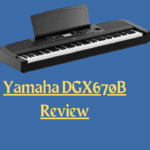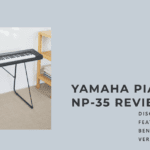As an experienced pianist and keyboardist, I was eager to get my hands on Yamaha’s latest budget-friendly arranger keyboards – the PSR-E373 and EW-310. I’ve owned several keyboards in the Yamaha PSR lineup over the years and have always been impressed with their quality and value, so I had high expectations for these new models.
After spending significant time playing, recording, and gigging with both the 61-key E373 and 76-key EW310, I’m happy to report that Yamaha has once again hit it out of the park with these keyboards.
| Image | Product | Feature | Price |
|---|---|---|---|
Top Pick
 | 1. Yamaha PSR-E373
| The PSR-E373 has 61 keys with touch response. It’s easy to express yourself with just the press of your finger. It connects directly to an audio interface. | Check On Amazon |
 | 2. Yamaha PSR-EW310
| The PSR-EW310 has a wider selection of effects. Reverb, Chorus, Delay and Harmonizer are available at multiple depths. | Check On Amazon |
 | 3. Yamaha P45
| This high-quality stage piano has been designed with input from some of today’s top touring artists and boasts a wide range of sounds including electric pianos plus strings and organs sampled from Yamaha’s famed CFX concert grand. | Check On Amazon |
 | 4. Casio PX-870
| This slim and stylish digital piano features Casio’s AiR Sound Source for realistic acoustic piano sound, along with hundreds of additional sounds and effects. | Check On Amazon |
 | 5. Casio PX-770
| The Casio Privia PX-770 is an affordable digital piano that offers a realistic piano sound and feel. | Check On Amazon |
Ready to make a masterpiece? These features guarantee success!
Yamaha PSR-E373 / PSR-EW310 Specs
- 61/76 unweighted synth-action keys
- Touch Sensitivity (3 types, Off)
- Sound: AWM Stereo Sampling, 622 preset tones
- 48-note polyphony
- Modes: Split, Dual, Duo Effects: DSP (38 types), Reverb (12 types), Chorus (5 types), Master EQ (6 types), Harmony (26 types)
- 2-track MIDI recorder 205 Accompaniment Styles, 150 Arpeggio Types
- 154 Preset Songs + Lesson Mode (Keys to Success)
- Connections: Headphone jack (1/4”), Sustain Pedal jack, AUX IN (stereo mini jack), USB to HOST (MIDI + Audio)
- W x D x H: 37.2” x 14.5” x 4.6” (94.5 x 36.9 x 11.8 cm) – E373 | 45.3” x 14.5” x 4.6” (115.1 x 36.9 x 11.8 cm) – EW310 10.1 lbs (4.6 kg) – E373 | 11.9 lbs (5.4 kg) – EW310
- The full specs can be found on Yamaha’s official site here

Overview and First Impressions
At first glance, the PSR-E373 and EW310 don’t look radically different from their predecessors in the PSR-E3XX series. The chassis retains the familiar matte black plastic construction, which feels sturdy and durable. The control panel layout has been tweaked slightly but will still feel familiar to those upgrading from an older PSR model.
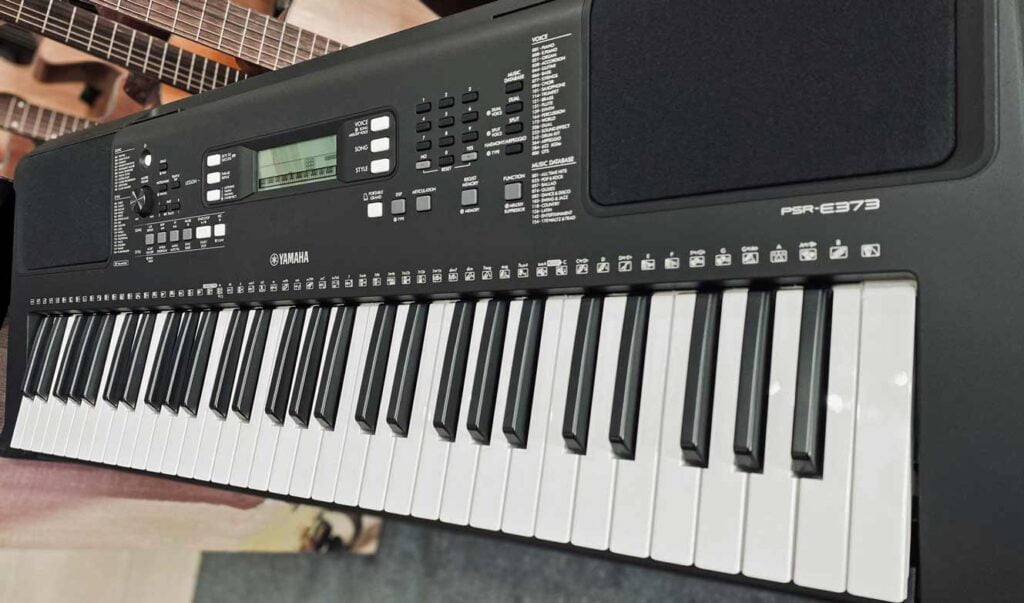
Powering up the keyboards and playing them for the first time, however, quickly reveals the major improvements Yamaha has made under the hood. The new sound engine delivers audio quality that is significantly better than previous PSR models – rich, vibrant tones with excellent dynamic response across the board.
The keybed also feels noticeably better than prior PSR keyboards I’ve played. The synth action keys have more tension and travel, providing better playability and more accurate triggering of sounds. They feel substantially less “mushy” compared to keys on older PSRs.
Sounds – A Major Step Up
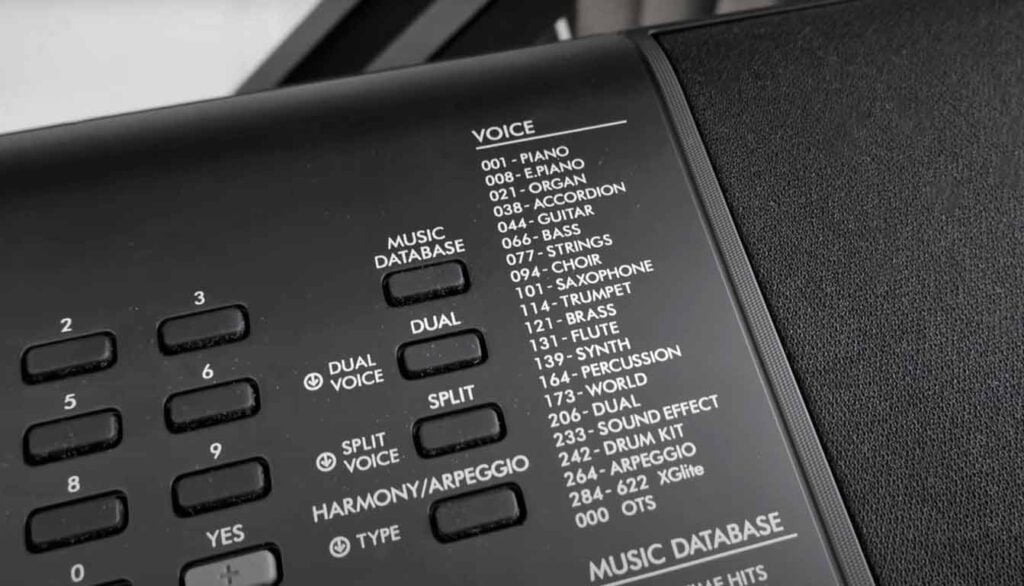
With 622 instrument voices, the PSR-E373 and EW310 boast a sizable tone library, covering all the essential sounds you’d expect in a modern arranger keyboard. Acoustic and electric pianos form the core of the soundset, followed by a wide variety of synths, organs, strings, brass, woodwinds, guitars, basses, and more.
The star of the show here is the “Concert Grand” piano sound. Yamaha used samples from their flagship CFX concert grand piano for this tone, and it shows – this is one of the best and most realistic piano sounds I’ve heard in this price range. The clarity, resonance and dynamics are excellent, making the Concert Grand a joy to play.
Beyond the piano sounds, the rest of the tone library maintains a consistently high level of quality. Having spent time with the keyboards across various musical genres – pop, rock, jazz, electronic, and more – I found appropriate and realistic sounding tones for everything I wanted to play.
The new sound engine delivers audio quality superior to anything in the price range of the E373/EW310. The tones sound richer, fuller and more vibrant compared to the PSR-E363 and other competitors. Playing with different velocities also triggers noticeably better samples, adding to the realism and expressiveness.
Effects and Features
A good effects engine is crucial for shaping and enhancing sounds, and the PSR-E373/EW310 deliver here as well. 38 high-quality DSP effects allow you to add spacious reverb, chorus, distortion, rotary speaker emulation, and more. I especially liked using the different overdrive/amp simulators on electric piano and organ sounds – they sound fantastic and are lots of fun to play with.

Beyond just the core sounds and effects, these keyboards pack a ton of features that make them versatile for different scenarios. The auto-accompaniment styles provide full backing bands across different genres that are great for practice and performance. I was able to quickly create professional-sounding arrangements by simply playing chords and melody lines.
Other notable features include a 150 arpeggiator, dual/split/layer modes for combining sounds, a 2-track MIDI recorder, and compatibility with Yamaha’s free Chord Tracker app. There’s also a solid built-in lesson system for beginners.
Playability
For any keyboard, the quality of the keybed – the keys themselves – is integral for playability. As mentioned earlier, the synth-action keys on the PSR-E373/EW310 are substantially better than on prior PSR models.

The keys have a more realistic weight and movement to them. While still lighter than fully weighted keys, the added tension provides better control and expressiveness. The keys are velocity-sensitive, and Yamaha’s velocity implementation here is excellent – dynamic changes translate naturally to volume/timbre changes in the sounds.
The keys have a matte finish that provides a nice grip. After extensive playing, I found the action comfortable and responsive. The keys are ideal for a wide range of playing styles – from soft ballads to aggressive solos, fast runs to intricate jazz comping.

The 61-key E373 model will be sufficient for most beginners and casual players. For those needing the extended range, the 76-key EW310 provides the same great keybed with 15 additional keys. The full-size keys are ideal for proper technique development.
Connectivity
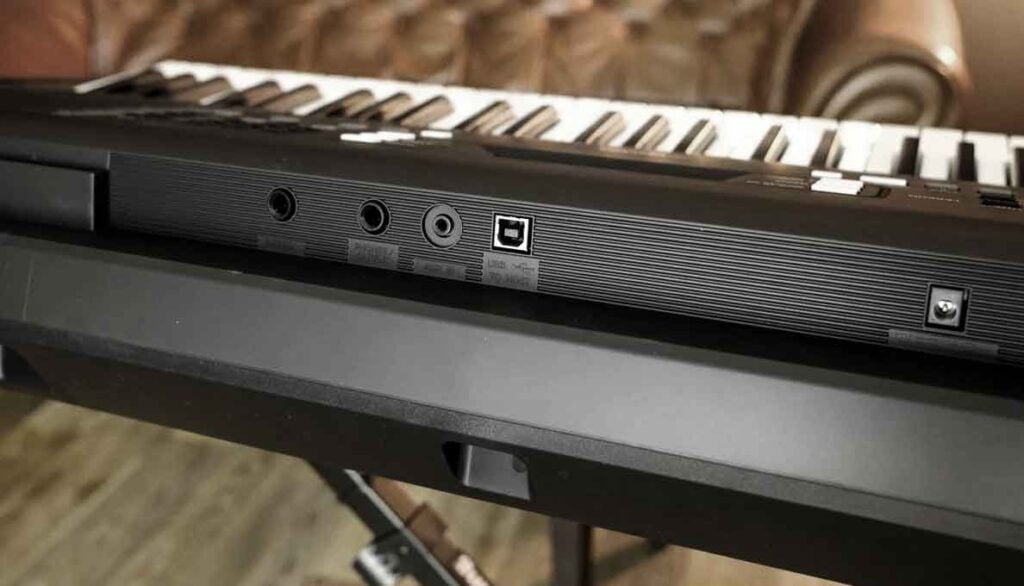
For on-the-go playing and practice, the built-in speakers on the E373 and EW310 provide adequate sound. The audio is clear without any noticeable distortion even at higher volumes. However, to truly appreciate the sound quality, I recommend using headphones or external speakers.
Both keyboards include a standard 1/4″ headphone jack – a must for quiet practice. The stereo aux input allows connecting and playing along with music from a phone, tablet, or MP3 player. A sustain pedal jack enables using a foot pedal for prolonged notes and expressive playing.
For recording and computer connectivity, there’s a standard USB to host port. I had no issues using a simple USB cable to connect the keyboards to my laptop for MIDI and audio over USB.
Ease of Use
Considering the depth of features, Yamaha did a decent job keeping the interface manageable. The most important sounds and functions have dedicated buttons on the front panel for quick access. I didn’t need to dig into menus too often for day-to-day operation.
That said, there is a learning curve, especially for newer players. The displays are small and text-based, not as intuitive as touch interfaces on more expensive keyboards. Mastering all the advanced functions like registering custom sounds/setups takes time.
The included manuals are well-written, providing good explanations and step-by-step instructions. I’d recommend new owners take the time to read through them to get a handle on everything these keyboards can do.
There are some annoyances that Yamaha should address in future updates. For example, reverb is on by default for the main piano sound – you have to turn it off via a menu. An option to default to a dry piano sound would be better. The record button also requires an odd 2-second long press to start recording.
Overall though, the learning curve is reasonable for the amount of features packed into the E373/EW310. A little bit of initial setup pays off with instruments that can cover a lot of musical ground.
Portability
Weighing in at around 11 lbs, these keyboards are relatively lightweight for their size. The chassis has integrated handles cut into the top that make carrying the instruments easy.
I found them very portable – easy to transport to gigs or rehearsals. The E373 fits easily into a standard keyboard bag. The larger EW310 requires a slightly bigger bag but is still manageable to carry around by one person.
Between the two, the 61-key E373 gets the edge for portability and playability when used on a tabletop or keyboard stand. The deeper EW310 is a bit more awkward in these scenarios, but offers the benefit of the extended key range.
Standout Features

To summarize, here are some of the most impressive capabilities and features of the PSR-E373/EW310:
- Concert Grand Piano Sound – Super realistic and expressive grand piano tone that punches above its weight.
- Vast Tone Library – Over 600 high quality instrument sounds covering all categories.
- Auto Accompaniment Styles – 205 different backing band arrangements in various genres.
- Improved Keybed – Very playable semi-weighted synth action keys.
- DSP Effects – 38 different effects like reverb, chorus, overdrive for enhancing sounds.
- Connectivity – USB MIDI/audio, aux in, pedal support for flexibility.
- Portability – Lightweight and easy to transport to gigs or practice spots.
Drawbacks
No keyboard is perfect, and there are a few limitations to note with the PSR-E373/EW310:
- No Pitch Bend Wheel – Lack of this common keyboard controller is disappointing.
- Small Display – Text-based LCD screen feels dated compared to larger color displays.
- Menu Diving – Many secondary functions require digging into multi-level menus.
- No Power Supply – Must use 6x AA batteries or optional adapter.
- Mediocre Speakers – Acceptable but upgrading to external speakers is recommended.
- Factory Presets – Many of the factory voices/styles are overproduced and cheesy sounding.
While none of these are dealbreakers for me, they may be worth considering depending on your needs as a player.
Recommendation
Taking everything into account – sounds, playability, features, value – I can confidently recommend both the Yamaha PSR-E373 and PSR-EW310 keyboards.
For beginners or casual players looking for their first serious keyboard, these are excellent choices that will provide an enjoyable playing experience and room to grow. Intermediate players will also appreciate the authentic sounds and responsive keybed.
The improvements Yamaha has made to the sound engine and keybed make these keyboards feel notably more premium than their predecessors. At their affordable price point, the PSR-E373 and EW310 deliver outstanding quality and performance.
Between the two models, choose the 61-key E373 if portability is critical or you don’t need the extended key range. Go for the 76-key EW310 if you want those extra 15 keys for playing large chords or wide-ranging solos. Either way, you’re getting an incredible value that will provide years of musical enjoyment.
So in closing, whether you’re a parent looking for your child’s first real keyboard or a hobbyist seeking impressive sounds on a budget, the Yamaha PSR-E373 and PSR-EW310 deserve strong consideration. These keyboards punch well above their weight class – don’t let the modest prices fool you. Yamaha has delivered yet again with these fantastic arranger keyboards.


